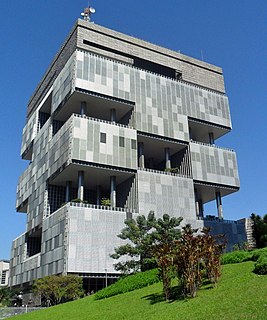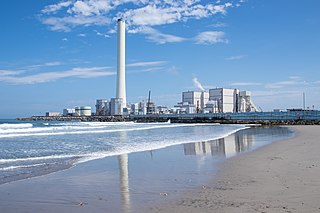
India is the world's third largest producer and third largest consumer of electricity. The national electric grid in India has an installed capacity of 375.32 GW as of 31 December 2020. Renewable power plants, which also include large hydroelectric plants, constitute 36.17% of India's total installed capacity. During the 2019-20 fiscal year, the gross electricity generated by utilities in India was 1,383.5 TWh and the total electricity generation in the country was 1,598 TWh. The gross electricity consumption in 2019-20 was 1,208 kWh per capita. In 2015-16, electric energy consumption in agriculture was recorded as being the highest (17.89%) worldwide. The per capita electricity consumption is low compared to most other countries despite India having a low electricity tariff.

A fossil fuel power station is a thermal power station which burns a fossil fuel, such as coal or natural gas, to produce electricity. Fossil fuel power stations have machinery to convert the heat energy of combustion into mechanical energy, which then operates an electrical generator. The prime mover may be a steam turbine, a gas turbine or, in small plants, a reciprocating gas engine. All plants use the energy extracted from expanding gas, either steam or combustion gases. Although different energy conversion methods exist, all thermal power station conversion methods have efficiency limited by the Carnot efficiency and therefore produce waste heat.

Florida Power & Light Company (FPL), the principal subsidiary of NextEra Energy Inc., is a Juno Beach, Florida-based power utility company serving roughly 4.9 million accounts and 10 million people in Florida. It generates, transmits, distributes and sells electric energy.

Orot Rabin is a power station, as of 2016 Israel's largest. It is currently a 2.59GW coal-fired plant, although some of its generating units are in the process of conversion to a single-shaft combined-cycle gas power plant. It is situated on the Mediterranean coast in Hadera, Israel and is owned and operated by the Israel Electric Corporation (IEC). The older, unmodernised four of its total six coal-fuelled units will be closed by mid-2022 in order to eliminate this major source of air pollution in the country.
The energy policy of India is largely defined by the country's expanding energy deficit and increased focus on developing alternative sources of energy, particularly nuclear, solar and wind energy. India attained 63% overall energy self-sufficiency in 2017.

Brazil is the largest energy consumer in South America. It is the most important oil and gas producer in the region and the world's largest ethanol fuel producer. The government agencies responsible for energy policy are the Ministry of Mines and Energy (MME), the National Council for Energy Policy (CNPE), the National Agency of Petroleum, Natural Gas and Biofuels (ANP) and the National Agency of Electricity (ANEEL). State-owned companies Petrobras and Eletrobras are the major players in Brazil's energy sector, as well as Latin America's.

Ensuring adequate energy supply to sustain economic growth has been a core concern of the Chinese government since 1949. The country is the world's largest emitter of greenhouse gases, and coal in China is a major cause of global warming. However, from 2010 to 2015 China reduced energy consumption per unit of GDP by 18%, and CO2 emissions per unit of GDP by 20%. On a per-capita basis, it was the world's 51st largest emitter of greenhouse gases in 2016.
Since 2013, total primary energy consumption in India has been the third highest in the world after China and the United States. India is the second top coal consumer in the year 2017 after China. India ranks third in oil consumption with 221 million tons in 2017 after the United States and China. India is net energy importer to meet nearly 45% of its total primary energy.

Enel Russia is a Russian power generation company created by the reorganization of RAO UES, a former united power company of Russia. The company is registered in Yekaterinburg and its headquarters are in Moscow. The Italian Enel Group owns a majority stake of the company (56%).

Energy in Armenia describes energy and electricity production, import and consumption in Armenia.

The Tilbury power stations were two thermal power stations on the north bank of the River Thames at Tilbury in Essex. The 360 MW dual coal- and oil-fired Tilbury A Power Station operated from 1956 until 1981 when it was mothballed, prior to demolition in 1999. The 1,428 MW Tilbury B Power Station operated between 1968 and 2013 and was fueled by coal, as well as co-firing with oil and, from 2011, biomass. Tilbury B was demolished in 2016-19. Since 2013 three other power stations have been proposed or constructed in Tilbury.

Hirono Thermal Power Station is a fossil-fuel power station operated by JERA in the town of Hirono, Fukushima, Japan. It located on the Pacific coast and is currently the seventh largest thermal power station in Japan.

Ravenswood Generating Station is a 2,480 megawatt power plant in Long Island City in Queens, New York. It is owned and operated by LS Power/Helix Energy Solutions Group. The plant is fueled primarily by fuel oil and natural gas which heats the boilers.
Energy in Serbia describes energy and electricity production, consumption and import in Serbia.
The Tunghsiao Power Plant or Tongxiao Power Plant is a gas-fired power plant in Tongxiao Township, Miaoli County, Taiwan. With the installed capacity of 1,815 MW, the plant is Taiwan's second largest gas-fired power plant after Tatan Power Plant.
Myanmar had a total primary energy supply (TPES) of 16.57 Mtoe in 2013. Electricity consumption was 8.71 TWh. 65% of the primary energy supply consists of biomass energy, used almost exclusively (97%) in the residential sector. Myanmar’s energy consumption per capita is one of the lowest in Southeast Asia due to the low electrification rate and a widespread poverty. An estimated 65% of the population is not connected to the national grid. Energy consumption is growing rapidly, however, with an average annual growth rate of 3.3% from 2000 to 2007.
The oil and gas industry in India dates back to 1889 when the first oil deposits in the country were discovered near the town of Digboi in the state of Assam. The natural gas industry in India began in the 1960s with the discovery of gas fields in Assam and Gujarat. As on 31 March 2018, India had estimated crude oil reserves of 594.49 million tonnes (MT) and natural gas reserves of 1339.57 billion cubic meters (BCM).











